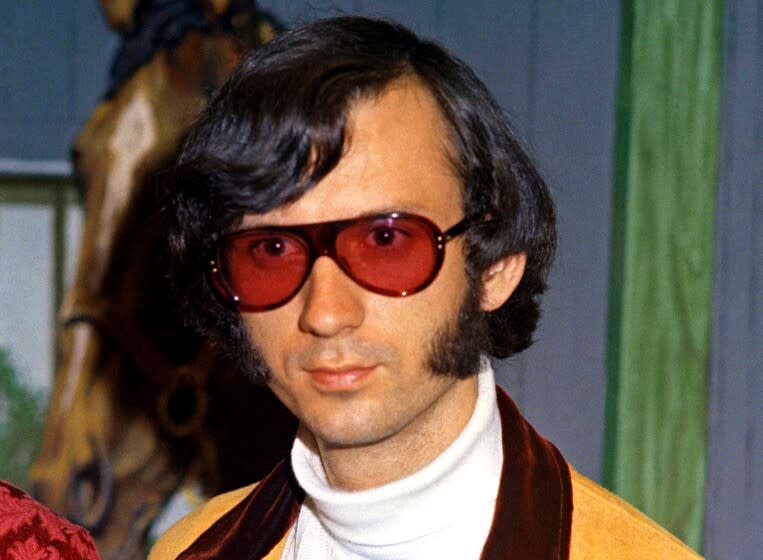Appreciation: More than a Monkee, but a Monkee to the end

Michael Nesmith — Monkee Mike, Nez to fans — died Friday at the age of 78, leaving Mickey Dolenz the last of the Monkees after the deaths of Davy Jones in 2012 and Peter Tork in 2019. Formed for a 1960s NBC sitcom, the group transcended its casting-call roots to make a mark on its time, and times to follow.
Nesmith was one of hundreds who answered a semi-legendary Variety ad for “Folk & Roll Musician-Singers for acting roles in new TV series. Running parts for 4 insane boys.” By intention or happenstance, the band was drawn half from traditional show business and half from the scuffling streets. Jones had played the Artful Dodger in “Oliver!” Dolenz was a child actor best known for the series “Circus Boy.” By contrast, Tork was a multi-instrumentalist folkie transplanted to Hollywood from Greenwich Village, while Nesmith, a long tall Texan (even taller in his signature knit wool cap), was a singer-songwriter with a publishing deal for his songs and a handful of singles to his name. As sometimes happens, four strangers created chemistry. The musicians were natural actors, the actors were musical.
Lean and laconic, Nesmith seemed the band’s voice of authority. In the looking-glass Beatles world of "The Monkees," he was its John Lennon, the apparent if unstated leader, and there is an air of nonchalant authenticity, even a maturity about him. He seemed to possess secret knowledge, parceled out in dust-dry quips. Though he was as able a comedian as the others — he’d hosted hoot nights at the Troubadour — and did his fair share of wacky romping, one could sense, beyond the scripted laugh-tracked fantasies, a serious person, a musician. If you were a reader of songwriting credits, you’d note that he contributed songs to even the earliest albums, and if you were a credit reader whose interests lay beyond the Monkees, that he’d written “Different Drum,” a hit for Linda Ronstadt and the Stone Poneys and that the Paul Butterfield Blues Band cut his “Mary, Mary” before the Monkees' own version (produced by Nesmith) was released.
The series, which won an Emmy in 1967, ran from 1966 to '68. Not surprisingly, the non-actors left first — Tork in 1968 and Nesmith in 1970, each leaving a considerable amount of contractual money on the table. Soon after, Nesmith returned to the life of a straightforward, songwriting recording artist with the First National Band, a pedal-steel-inflected harbinger of country rock. (“Joanne” is its best known song.)
Ironically, it was Nesmith who most upheld his TV band’s legacy as an early explorer of the intersection of music, video and comedy. (It is said that his Nickelodeon video show “Pop Clips” planted the seeds of MTV). His short-lived 1985 NBC summer series “Television Parts,” a sort of on-air sequel to his bestselling video-only 1981 “Elephant Parts” — it won the first Grammy for video — included early appearances by Garry Shandling, Jay Leno, Jerry Seinfeld, Whoopi Goldberg and Arsenio Hall, as well as the first iteration of “Deep Thoughts by Jack Handey,” later a staple of “Saturday Night Live.” He wrote and directed the 1997 ABC special “Hey, Hey, It’s the Monkees,” which found the band members in their old sitcom roles, still trying to make it. He was ever up to lampoon himself.
Nesmith seems always to have kept busy; he had family money — his mother invented the typing corrective Liquid Paper (ask your grandparents) — success as a multimedia entrepreneur, and the security to follow myriad creative interests and pursuits whether they paid off or not. Flitting in and out of public consciousness, he produced films, including “Repo Man,” and albums for other artists, including the great “L.A. Turnaround” by Britain’s Bert Jansch. He wrote a couple of novels and a memoir. He made records and went on tour. He appeared on “Portlandia.”
And sometimes he was a Monkee. If it’s not quite fair to say that, in the years after the show dissolved, he was the reluctant Monkee, his participation in various tours and reunions and fleeting personal appearances always seemed to be the wild card; and his presence, when granted, a kind of benediction.
And as time went on, the Monkees' reputation only solidified. If the band’s 1968 movie “Head” seemed meant to prove the band was in on the joke, cognizant of its Hollywood soundstage roots, I know few musicians who don’t take them seriously, and lovingly. Their songs are covered without irony. The 2016 “Good Times!,” the lovely last Monkees album, produced by the late Adam Schlesinger, has songwriting contributions from Andy Partridge, Rivers Cuomo, Paul Weller and Noel Gallagher, along with Nesmith. If you have not heard “Me and Magdalena,” Nesmith’s duet with Dolenz, written by Ben Gibbard, you have a treat coming.
And in the end, what isn’t authentic? Monkees songs were on the same radio stations as those by bands not made for TV. The Beatles were characters in a Saturday morning cartoon series — it may have been the first place I heard that psychedelic death anthem, “Tomorrow Never Knows.” The Archies, whose “Sugar, Sugar” topped charts in 1969, were only ever a cartoon. To this day, some of the world’s biggest pop groups are formed out of casting calls. There’s no shame in it; time creates history and delight wins out.
It was less than a month ago that Nesmith finished a 40-date tour alongside Dolenz, a deep-cut dive into the band’s legacy, at L.A.’s Greek Theatre. He was more than a Monkee, but he was a Monkee to the end.
This story originally appeared in Los Angeles Times.
